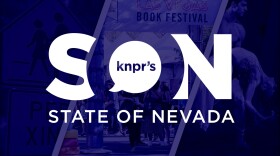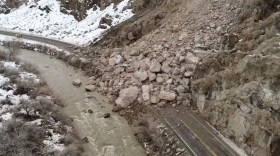There’s an emerging push around the country to eliminate right turns on red traffic lights.
The practice originated in the 1970s as a way to save gas during the oil crisis. The idea was it would limit the amount of time people burned gas while idling at stoplights. And, some studies have shown turning right on red reduces traffic delays and increases capacity.
But does it also create more dangers for drivers, pedestrians and bicyclists? We also talked about other traffic and safety issues. For instance, along with the usual vehicle deaths here, there’s been a rash of motorcycle deaths in the valley lately.
There’s no other way to say it: Our roads are dangerous.
State of Nevada host Joe Schoenmann spoke with Erin Breen, the coordinator of UNLV's Transportation Research Center; Capt. Jeff Coday with the Las Vegas Metropolitan Police Department's traffic bureau; Clark County Commissioner Michael Naft; and Andrew Bennett, the director of the Clark County Office of Traffic Safety.
To date this year, 46 pedestrians have been hit and killed by cars. That doesn’t include North Las Vegas or Henderson. Coday said failure to lead is one of the main causes of fatal crashes.
“Be alert, and just slow down,” he said. “Anytime that you're making a right turn on red, or you're making a left turn, being able to see and pay attention to what's going on around you in the vehicles that are oncoming, it's really critical to keeping all drivers and pedestrians safe.”
Alan Snel, a Las Vegas journalist and bicyclist, called into the program on Monday to share that while cycling, he was hit by a vehicle last month.
“I'm bicycling right through the intersection and she crashed into me. In the middle of her turn, she did not see me. I actually have a mirror on my sunglasses that I use to scan traffic behind me, and I'm scanning traffic in front of me. A car just literally came up on me … without a moment, it was right on top of me,” said Snel, who is still recovering.
Traffic issues are unfortunately a unifying issue for all walks of life in Southern Nevada. Naft is one of many people trying to improve safety on the roads. He points not to driver nor pedestrian error, but infrastructure.
“We have attached sidewalks throughout the whole valley that puts all of our vulnerable road users in jeopardy,” he said. “We could change rules and policies and laws and ordinances. But I think the first step is to look at the infrastructure.”
An example he gave was detached sidewalks, which are separated from the road with grass or landscaping.
“Looking at these other potential solutions is also part of the puzzle,” Naft said. “But I think it also requires looking at some unintended consequences that might come from it.”
Breen said while we have some intersections with a leading pedestrian interval, we need more. That’s a traffic signal that gives pedestrians more time to enter the crosswalk before vehicles are given a green light.
“So that they’re visible on the sidewalk,” she said. But, a major issue is drivers not paying attention.
“It's like they have a mentality of ‘I'm driving a 4,000 lb. vehicle, you better get out of my way.’ And what that leads to, is people who walk all the time purposely not using the crosswalk, because they feel that they're safer outside of the crosswalk. So we teach pedestrians to behave badly."
It’s not just right turns on red that cause issues, in many crashes, it’s the flashing yellow light for left turns.
There are two intersections that are now designed to be more reactive to pedestrians in those scenarios: Desert Inn Road and Hualapai Way, and Desert Inn Road and Town Center Drive. Breen said at those two locations, if you’re a pedestrian, you push a button to cross the street, which suppresses the left turn arrow so that drivers can only go on green. They’re looking at intersections along Maryland Parkway to further test this system.
In peak hours throughout unincorporated Clark County (not within city borders), if a road is three lanes in one direction or wider and over 45 mph, the flashing yellow light is now turned off during morning and evening commutes. He said his office believes it’s working, and they’re probably going to expand it.
Another program that Las Vegas Valley drivers could see soon is speed cameras at lights to automatic traffic tickets. It’s a hot topic in the Nevada Legislature, but the bill draft request (BDR) was recently approved, allowing the topic to be discussed in the next legislative session.
“Specifically, we're having an issue with school zones,” Bennett said. “There was a great article in the [Las Vegas Review-Journal] about how many kids get hit in school zones. I think anything that we can do to keep our kids safe as they're going to school is going to be the conversation.”
Erin Breen, coordinator, UNLV Transportation Research Center; Jeff Coday, captain, Las Vegas Metropolitan Police Department's traffic bureau; Michael Naft, commissioner, Clark County; Andrew Bennett, director, Clark County Office of Traffic Safety










